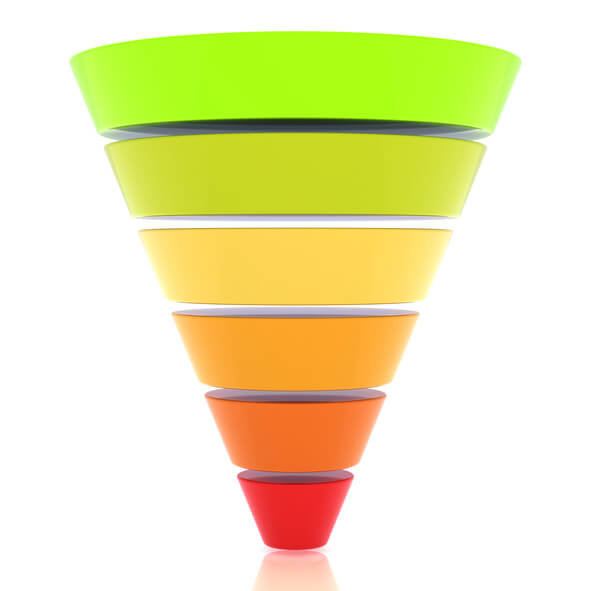
The Ultimate Guide to Creating a Digital Marketing Budget That Drives Results
Creating an effective marketing budget first relies on a firm understanding of what you want to accomplish as a business. Do you want people to download your latest white paper, buy your product, or fill out a form to get service? You may want as many people as possible to know who you are. Either way, you’ll need to establish what accomplishment your business needs to achieve, and budget for a way to receive more of it. Do you want more revenue? Do you need more leads? Once you answer these questions, you’ll need to match a channel mix to your budget. Because, the more valuable an action you want your audience to take, the more costly it will become.
Here are some examples of valuable actions:
- Filling out a contact form
- Buying something online
- Scheduling an appointment
- Downloading an app
- Signing up for a newsletter
Understanding the Marketing Funnel
Before we get into the different platforms of paid media, let’s examine the marketing funnel. The marketing funnel is what we use to help create messaging that matches a person’s state of mind during a specific stage of their process—whether they are buying products or seeking information.
The standard funnel has four stages: awareness, interest, consideration, and conversion. A basic understanding of the funnel is necessary to create a strategy that pairs business objectives with budgets and channels to effectively meet those goals.
First, let’s learn about each stage of the funnel and how your budget size is impacted.

Creating Awareness
The awareness stage is the first step in the customer journey. This is where you, as a business, attempt to attract people and establish yourself in the marketplace. During this phase, messaging is very brand focused. Budgets in this stage can be as large as you’d like. However, when you take into account the geographic area you want to reach, you can maximize small budgets by selecting the right platforms and using captivating ad creative.
Building Interest
During the interest phase of the funnel, people engage with content in hopes of learning more about your business, services, and products. Messaging is centered around reinforcing your brand and sharing what makes you unique and what problems you can solve for them. As interest builds, people eventually start to consider you legitimately. In this stage, your budgets may begin to expand to allow your audience to engage more with your content and potentially take more valuable actions.
To Be Considered
As they move into the consideration stage of the funnel, people begin looking more intently at where they want to spend their money or time online. An example of messaging in this stage might be offering a special coupon through the collection of personal data such as email or phone numbers. Your audience should already be quite familiar with you as they have interacted with you multiple times through various channels. Budgets in this stage depend on the specific valuable action you want your audience to take. If your goal is to gain more views on your content, your budget may remain similar in size to that of the beginning of the funnel. If your goal is to build an email list by sharing a downloadable infographic, you’ll need to increase your budget to match the quality of action you want your audience to take.
Get The Conversion
The conversion stage is solely focused on your primary goal. Revisiting the most valuable action you set forth early: Do you want more sales? Need more leads? More app downloads? This stage is all about pushing for those conversions because you want a highly valuable action taken and to a particular, well-intended audience. And it’s not just you bidding on serving your ad to those who are likely to take valuable action; it’s you plus your competitors. And since this pool of people is much smaller than in previous stages of the funnel—it can quickly get costly.
The Extended Funnel
The funnel doesn’t simply end once someone takes the valuable action you desired them to. In some instances, you may actually extend the funnel and include two very important stages for two very important reasons. The loyalty and advocacy stages are ones we, as consumers, are very much aware of whether we recognize them or not. The loyalty stage specifically speaks to retaining customers and getting them to come back and get more of what a business has to offer. In this stage, you may market to your existing customers a brand new loyalty program you just launched or a special promotion only valid for members. The loyalty stage creates opportunities for both paid and organic channels to be used, and budget-wise can be on the low end of the spectrum since you are re-engaging a known audience.
The advocacy stage is typically focused on organic channels and allows organizations to curate a healthy amount of user-generated content for future paid and organic promotions. This stage is centered around you empowering your customers to share the positive experience they had with others. This might come in the form of asking for reviews or offering referral codes. Because we are connecting with a known audience and the messaging we use, it’s rare we a paid channel is used in this stage, however, not impossible to do so. And again, since this audience is known, small budgets are very effective.
Creating a Marketing Budget that Aligns with Your Business Goals and Objectives
Now that we have an understanding of the funnel, we can create a budget based on meeting what we want to accomplish. The second factor to consider when crafting a budget is the number of times you’ll need to get your ad in front of your target audience to get them to take action and how much that will cost, from a bare minimum perspective.
The Importance of Frequency
The repetition component of marketing is called frequency. This metric helps us understand how often, on average, our selected audience has seen our advertisement on any platform. The concept is called the rule of seven. The rule of seven states that a potential customer must see a message at least seven times before being provoked to take action. By paying attention to the frequency metric, we can account for ad fatigue so your audience doesn’t get annoyed seeing the same advert too often. You also must ensure your budget is large enough to serve an ad one to three times per platform to entice your audience to take action. And, of course, the more valuable the action, the more expensive it will become to find the person enough times across various channels to get the job done.
Frequency is an important metric to consider when you understand how each marketing channel serves a different purpose, and people have different intentions while using them. For example, social media platforms are used to communicate with friends, family, things, and ideas you enjoy. Since the platform’s primary means isn’t shopping or seeking products or services, you must break through the noise. Because people who use these platforms have no intention of purchasing from a business like yours at that specific time, reaching people likely to engage or interact with your ad costs more.
Budgets For Every Stage and Channel
When attempting to generate awareness and build a reputation for your brand, you focus on reaching as many people as possible for as little as possible. Budgets in the early phases of the funnel can be as small as $500 a month to as large as you can reasonably go. At this point, it’s important to remember that the U.S. Small Business Administration recommends spending seven to eight percent of your gross revenue on marketing. The smaller the budget, the longer it will take to reach the segment of your audience who will take valuable action successfully.
Paid Media Channel Options
Various types of paid media options exist, and each plays an essential role in the customer journey. And because each platform isn’t built the same, comprehending how they work together in the journey will help you figure out budgets and match channels per stage.

- Paid Search: Text-based ads that appear on search engines such as Google or Bing. Sometimes referred to as pay-per-click (PPC) or cost-per-click (CPC).
- Display: Graphic-based ads are typically referred to as banners but can be video, GIFs, HTML5 animations, etc., that can appear on various websites and apps.
- Paid Social: A subset of display ads with the same ad variation of creative but different formats to be featured on social media platforms.
- Over-the-Top (OTT): Usually, video-based creative appears on streaming services.
- Streaming Audio: Audio-based ads are served to consumers via streaming music/podcast services.
One of the most popular paid channels is paid search, and one of the few based on the person using it having a clear intention behind engaging in ads they see online. For example, when someone looks up “roofer near me“ that person wants a listing of all the roofers in close proximity to their location. But when people type “best wifi speaker” in Google, they intend to research and learn about the best available product. Paid search, in particular, is primarily used during the conversion stage of the funnel. Since search engines are all about intent and getting your ad in front of the right person willing to take action at the right moment in their buying journey, this makes this channel one of the most competitive and costly.
Nearly every other channel, social media, display, OTT, and audio require you to get in front of the right person multiple times at various funnel stages to effectively get them to take action. Any non-intent platform is often used at more than one stage of the funnel. To spread awareness, they are used in the early stages of the funnel and as the campaign progresses, your messaging shifts to encourage someone to take more valuable action in later stages.
How Algorithms Work
Each platform uses an algorithm based on machine learning and artificial intelligence techniques to constantly refine the understanding of what people are interested in to improve the relevance of advertisements shown to them. Algorithms consider many factors to ensure ads are served up to people that would most likely take the action the advertiser bid on.
Each platform lets you select an audience to target and serve ads to. You determine your target audience by selecting the interests and behaviors of people who you believe would be most interested in buying your product or service. From that pool of people you selected, the platform attempts to find people within that are more likely to take the action you want them to take. For example, suppose a car dealership is running a Facebook campaign to have people fill out their appointment form. In that case, Facebook will attempt to serve up their ad to those within their selected audience that is most likely to fill out a form after clicking on a Facebook ad. The action is highly sought after by other dealerships, so getting in front of someone who will complete the form is expensive.
How to Allocate Your Marketing Budget Across Channels and Tactics
When we build a digital marketing strategy, we must account for what action we want taken on each channel. The optimal way to allocate budgets is to consider an omnichannel approach that tracks data throughout several platforms and devices to create a consistent brand experience for the customer. Not only does this enable better online and offline experiences for the user, but it simultaneously helps you reach a wider audience of customers who are most likely to engage with your business. As you build a campaign within a platform, you specifically select what objective you want to accomplish and have to set a budget that will allow you to succeed.
In the awareness stage, as previously mentioned, it can cost as little as $500 per channel to as much as you can reasonably afford. This is because when building awareness, you are not trying to achieve a valuable action but instead trying to get as many people to see your ad as many times as possible per channel. Awareness audiences are usually huge, even in small geographic areas. Even when competition is high, getting in front of people in this stage can cost anywhere from $.10 per thousand people to $20 per thousand people. Budgets for awareness campaigns start at a minimum of $500 per channel per month.
For the interest and consideration stages, budgets must be determined based on what action you want people to take. The more valuable the action, the higher the cost will be. The cost itself is going to be determined by what the best spending practices are for each channel. In the interest stage, for example, if your goal is to build a highly engaged audience (perhaps one that likes to watch your videos on your website), you may be successful with a $1,500 budget on a social media platform. Ideal budgets in this phase range; however, minimum per channel per month, you’re looking at $3,000 – $5,000 for optimal success. These are bare minimum recommendations and heavily depend on what action you want your audience to take on each channel.
Conversion campaigns are geared at attempting to transform your audience into customers. Considering you are in constant competition with other brands and their budgets, all wanting to seek the same audience who is willing to complete a highly valuable action such as completing a purchase or filling out a quote form, it is necessary to have a large monthly budget per channel each month. One channel could easily run you $10,000 a month, meaning the ideal minimum for a conversion campaign that seeks to yield results should be at least $10,000 a month. Depending on where your audience lives online, through proper optimization, you may be able to allocate your budget to two or three different channels.
When looking at a complete omnichannel marketing strategy that accounts for each stage and includes a healthy channel mix of at least three channels considering frequency, an ideal monthly budget will average $20-$30k at the low to mid-end of the spectrum. Large brands allocate millions to digital media alone. In 2022, Nike spent $3.85 billion on marketing, and if we take some liberties and say 10% went to digital, that’s over $32 million a month.
The Importance of Tracking and Analyzing Your Marketing Budget Performance
Algorithms continuously adjust the placement and targeting of your ads based on the action you want to be taken, your bid, spending budget, expected engagement rate, and how many other companies are going after the same audience as you. Tracking and analyzing your digital marketing campaign progress allows you to measure success and determine if you’re meeting your goals. By analyzing your campaign results, you can identify opportunities for improvement, optimize your strategies and tactics, and make data-driven decisions.
Analyzing your campaign results also helps you optimize your budget allocation by identifying which channels and tactics deliver the best results for the best costs. Through the running of campaigns, you can gather important data about your audience’s behavior and preferences, which can help you improve audience targeting and inform decisions on more effective messaging and ad creative.
Let Us Help You Optimize Your Digital Marketing Campaigns
As you traverse through the world of digital marketing, the Think Integrated team can create strategies that optimize your budget. We will work to understand your ideal audience and keep track of what your competitors are doing so we can identify opportunities for differentiation and improvement. With a clear understanding of how channels work, we can effectively promote your business on various platforms. By properly tracking and analyzing your digital marketing campaigns, we can provide insights that help you improve your overall marketing strategy and drive better results.
And if you don’t know what you want to accomplish just yet, don’t worry! We’re here to help. Depending on your business goals and objectives, we can create a marketing strategy using minimum best spending practices for the channel mix that your audience uses, allowing your business to achieve success from the moment you start spending.